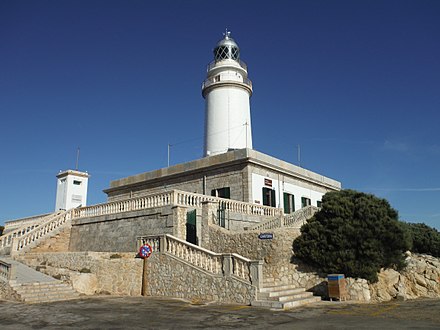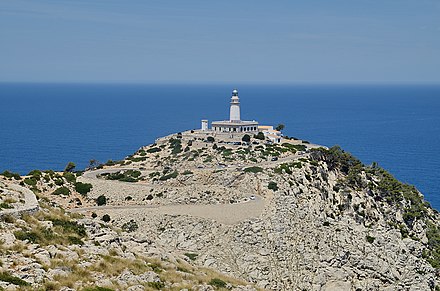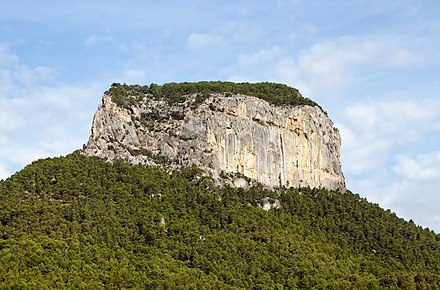Serra de Tramuntana - mountain range in the northwest of Mallorca
The Serra de Tramuntana is the mountain chain that runs along the north-west coast of Mallorca, reaching from Andratx to the Cap Formentor.
Cities

- Andratx — wonderful scenery and popular with the rich
- Calvià — busiest part of the island, with long and neat beaches, hotels, nightclubs, restaurants and shops
- Deià — an idyllic landscape with orange and olive groves on steep cliffs overlooking the Mediterranean
- Lluc — an important a place of pilgrimage for Catholics
- Magaluf — well-known as a stag-weekend and package-holiday destination for visitors looking for sun, sea and a wild nightlife
- Pollença — in the north-east some call it the second capital of the island
- Port de Pollença — a beautiful and quiet beach resort
- Sóller — one of the most popular destinations on the northern coast of Mallorca
- Sant Elm/San Telmo — a quiet beach resort north of Andratx
- Valldemossa — famous for the landmark Royal Charterhouse of Valldemossa, built at the beginning of the 14th century
Other destinations

- Cap Fermentor — the northernmost point of Majorca, on the Formentor peninsula, near Pollenca, has several lookout and viewing points
Understand
The Serra de Tramuntana runs along the north-western coast of Mallorca. From Andratx in the west to Cap Formentor in the north-east it has a length of about 50 km and a width of about 7 km. It elevates up to 1,445 m at Puig Major (which is not accessible for the public). The scenery is characterized by bizarre shaped limestone rocks, pine woods and grass, with some partly abandoned fincas in between. The most stunning feature is the many kilometers of dry stone walling, and the gnarled old olive trees some of which may be over 1,000 years old. The coastline is steep and has very few beaches. Limestone walls fall directly into the sea from a height of about 300 to 500 metres. The Serra de Tramuntana was declared a UNESCO World Heritage Cultural Landscape in 2010.
Get in
By car
This is the best option to travel in the Serra de Tramutana. The Ma-10 on its run from Andratx to Pollenca is by far the most scenic drive on Mallorca, although drivers should take care with the steep climbs and sharp bends, and expect to encounter hikers, cyclists and motorcyclists. Many places are only accessible with your own transport.
By bus
Public transport into the Serra de Transmuntana is good along all major arteries via TIB bus. From Palma de Mallorca buses run to Soller and via Andratx, Soller and Lluc to Pollenca on the Ma-10. There are buses from Palma to many destinations in the Traumantana, Esporles, Galilea, Puigpunyent, Valldemossa, Soller etc. It is possible to access the southern part of the coast (Estellence and Banyalbufar) via TIB bus from Palma via Esporles. There are buses to the northern locations (Lluc, Sa Calobra, Puig Major) via Inca and Soller.
By train
A tourist train (dead link: June 2020) runs between Palma and Sóller several times a day and is one of the islands main attraction. It's a scenic drive and a nice option for a day-out of Palma.
Get around
As public transport is rare a car will be the best option. Car rental is available at nearly every town and prices are relatively cheap.
See

Take a scenic drive along the R710 with some wonderful views of the rough mountain scenery and the coast. Sa Calobra is probably the island's, if not Spain's, most famous road; do the drive and find out why they built it.
Visit the Monastir de Lluc, and don't forget a visit to Pollenca for a break at the nice market. Puig de Pollenca is religious site from the 14th century, accessed on a wooded hill path with lookout points.
La Granja, near Esporles in the vicinity of Valldemossa, is a 18th-century finca in the mountain. The interior is filled with a beautiful collection of artefacts which recreate the life of the farm at the end of the 19th-century. And eat at the excellent restaurant if you have time.
Do

Hiking
The central point for mountain hikes is the place of pilgrimage named Lluc. Other good places are Soller and Pollenca.
Respect the private property and don't cross grounds if not permitted. If you pass a gate, leave it in the state you have met it, i.e. leave it open if it was open (otherwise the cattle cannot get to their drinking place) and close it, if it was closed (otherwise the cattle will escape.)
Biking
Rent a bicycle and cycle around the island
Aquatic
It is possible to take part in snorkelling and scuba diving from Sant Elm and other locations.
Buy
- Stop for a coffee at the nice market in Soller.
Market days
Eat
Many restaurants offer their services in Andratx, Soller, Valldemossa and Pollenca but cater mostly for the tourists.
Drink
Don't forget to stop for a drink in one of the many cafes at Pollenca's and Soller's market places.
Stay safe
Crime is no problem but the weather is! Keep in mind that weather changes may occur every time so take a jacket and warm clothings with you. The hiking trail along the Torrent de Pareis is especially dangerous after rainfalls so inform yourself about the weather. And don't forget to take something to drink.
Leave no valuables in your car at popular sites such as the view points (Miradors) near Formentor or elsewhere.